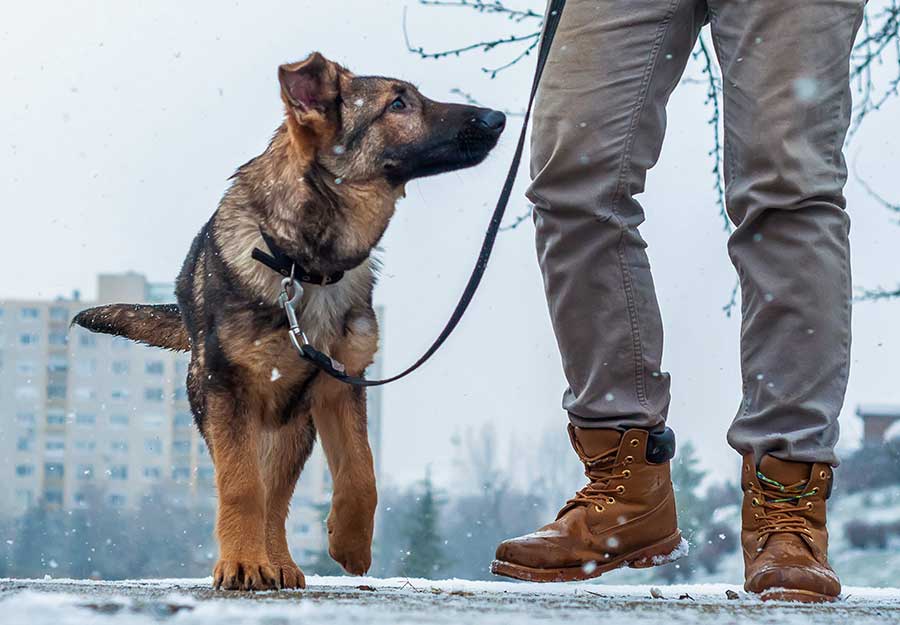
With its cold temperatures and inclement weather conditions, winter can pose some real risks to your pets while outside. However, most dogs will still need to have daily walks. Use these winter dog tips to keep your pet safe, comfortable, and healthy on his cold-weather walks.
Use these winter-weather dog tips to keep your pet safe, comfortable, and healthy on his cold-weather walks. Winter walks are fun, but you'll want to take precautions when you walk your dog.
Walking Your Dog In Winter
You may be asking, how can I exercise my dog in the winter? Many dog owners use a winter-season walk for exercise and mental stimulation. All canines need daily exercise for their mental well-being.
This question has many different answers - all depend on your pup's specific needs and the weather conditions outside. During the colder weather, you might want to keep your daily walks short.
You can expect that your dog will enjoy being outside as much as possible, as the inclement weather of winter can put a damper on your regular exercise routine.
If the temperature is above freezing, your pup may last longer and enjoy playing in the snow beyond just a short walk to "do their business." After all, who doesn't enjoy a winter wonderland? Outdoor adventures in snowy conditions are fun for your furry companions. Most dogs love snow and can even tolerate sub-zero temperatures with proper preparation.
Outdoor walks for up to 30 minutes (or shorter walks) are likely fine for moderate winter temperatures. With the right winter dog coat and dog winter boots, your dog may even want to stay out and play even longer.
Walking your furry friend in the winter provides essential physical activity for your dog, helping to maintain a healthy weight and prevent obesity-related health issues. The colder temps may also invigorate your dog, making the exercise more enjoyable - especially for Nordic or long-haired breeds.
Additional benefits of winter dog walking include:
-
- Mental Stimulation: Taking Fido for a walk exposes your dog to new sights, sounds, and smells, offering mental stimulation that is crucial for their well-being. The change in the environment can prevent boredom and contribute to a happier, more contented pet.
- Bonding Time: Walking your dog during the winter months fosters a strong bond between you and your canine friend. The shared experience of exploring snowy landscapes or brisk winter air creates positive associations and strengthens the human-animal connection.
- Socialization Opportunities: While wintertime walks may have fewer fellow dog walkers, the encounters your dog does have can be more meaningful.
- Healthy Coat and Skin: Exposure to cold weather can stimulate a dog's coat and skin health. The brisk air can promote a shiny coat and may reduce excessive shedding.
- Weight Management for Owners: Walking your dog in winter is beneficial for both parties. It provides an opportunity for dog owners to stay active during the colder months, promoting personal health and fitness.
- Energy Release: Dogs, especially those with high energy levels, need an outlet for their excess energy. Wintertime walks offer a controlled environment for your canine companion to release pent-up energy.
- Immune System Boost: Exposure to outdoor elements, within reason, can support the overall health of your dog's immune system. Canines appreciate fresh air just as much as their human counterparts.
- Improved Behavior: Dogs that receive regular exercise, even in winter, are often better behaved. Physical activity helps reduce anxiety, hyperactivity, and boredom, leading to a calmer and more well-behaved pet. Your pup will sleep better and even work up an appetite.
- Enhanced Sleep: Regular winter walks contribute to a tired and satisfied dog, promoting better sleep quality. A well-exercised dog is more likely to rest peacefully, translating to improved overall health and well-being.
25 Tips for How to Walk Your Dog in Winter
As Canadians, we know that life doesn't stop just because it's super cold outside, the roads are covered in snow and ice, and the frigid wind burns our skin. As much as you might prefer to hibernate through the worst of the season, your dog needs to stay active and stick to a healthy routine all year round.
Walking dogs in winter can be challenging. You need to take steps to protect both yourself and your pet from the weather and learn to identify the signs of your dog getting too cold.
To make sure you and your pooch stay safe when going on winter dog walks, we put together 25 hot tips for walking your dog in cold weather:
1. Plan Ahead in Cold Weather
In the winter, it's important that dog owners plan their trip ahead of time.
Check the forecast and wind chill before you start walking your dog. Often, it can be colder outside than you initially thought, and your pup will need a warm winter jacket.
Rather than taking a long route with only one way back, choose a busy path with a few walk-length options if you are unsure about the weather. Leave exploring with your dog for clear, cool days.
2. Look for Cues Keeping Your Dog Warm
While you should know what your dog's breed says about his cold threshold, you should also pay attention to individual cues such as the dog's body temperature. Dogs will let you know when they've had enough of the cold - especially elderly dogs.
While you can let your dog play outside in the cold weather, never leave your pet unattended for long periods of time, particularly if they are a small breed or a breed with little cold protection, even if they have a coat and boots.
3. Keep It Short and Sweet!
How long can a dog walk in the snow before you bring the dog inside? On very cold days, limit your walks to less than 30 minutes at a time. Some dogs may be able to handle more with an abundance of body fat, especially if they are properly dressed for the weather, but on very cold days, multiple short walks are better than one long one.
4. Keep Your Dog's Toe Hair Clipped
Keep the hair between your dog's toes clipped short for more comfortable winter walking. Ice and snow can accumulate on the hair of the dog's paws, causing temporary lameness or making it difficult or painful for your dog to walk.
5. Choose the Right Dog Boots
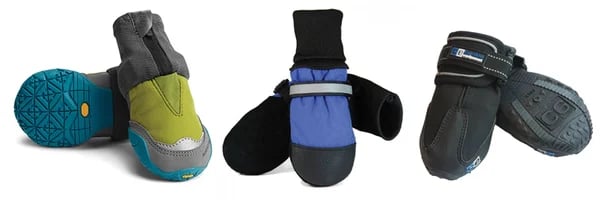
Do dogs need boots? Protective booties are a practical necessity for many dogs and can be beneficial for all walking dog in winter.
Protecting your pooch's paws from the harsh weather elements, such as snow and ice, that can dry out paws and make your dog chill faster is the best way to make sure your dog's winter walks are safe.
Winter dog boots also keep your dog's sensitive foot pads from salt and chemicals that are put on the street to remove ice. Your dog's feet can tolerate the cold ground better with booties.
6. Apply First Aid
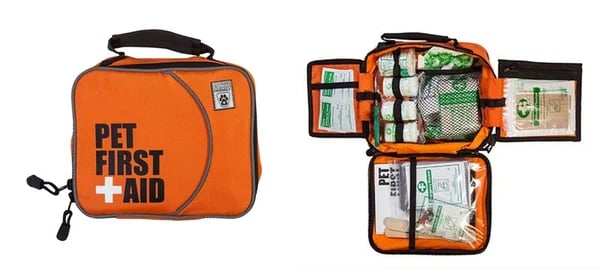
If your pup's paws do happen to split and there is an open sore, taking appropriate dog first aid care is crucial. Clean your dog's wound first with water.
Use an antibacterial first aid spray or lotion for pets to prevent infection, or try a little Neosporin in a pinch. Wrap the area with a clean gauze or pet bandage.
Keep walks to a minimum during the healing process to ensure your dog's health. If you are walking your dog while her paw is still healing, make sure she wears boots to keep irritants out and to protect the wound from reopening.
7. Moisturize Paws
After cleaning your pet's paws, use a pet-safe conditioner or paw wax to prevent them from drying out. Dry winter air can make dog paws rough, cracked, and even split.
Make sure the moisturizer you choose is non-toxic and safe for dogs, as your pet will likely lick her paws.
Coconut oil is an excellent choice. Not only is it an effective moisturizer, but it is a healthy source of fats and vitamins when ingested, too.
8. Wipe Your Dog's Paws
Pet parents should always wipe your canine's paws after a winter walk. Use a warm, wet washcloth and a towel to dry, or use pre-moistened pet wipes for convenience.
Washing removes salt or ice-melt chemicals from your dog's paws before he licks them.
9. Use Pet-Safe Traction
Speaking of salt, most de-icing chemicals and chemical ice melts are not safe for pets. In fact, road salt and commercial ice melters are probably the biggest winter hazards for dogs living in the city. Spilled antifreeze can prove deadly if ingested.
The sharp crystals hurt to walk on and have a burning, drying effect on their delicate pads, especially if they stick between doggy toes. Salt can also be damaging to sidewalks and corrode metal wiring, so it's no wonder that it can irritate the paws of your furry friend.
If ingested, these chemicals are even more dangerous, and, unfortunately, many pets are drawn to the chemical's sweet taste. If your dog licks the antifreeze, it could prove deadly.
Unlike table salt, road salt can include contaminants as well as high amounts of minerals and heavy metals that could prove toxic to your pet, especially toy breeds and senior dogs.
If ice melts are necessary for your and your pet's safety, opt for pet-safe products like Groundworks Natural Ice Melter and make sure your dog isn't hunting down and eating the ice melt on your property.
Investing in a pair of dog boots can protect your pup's paw pads on icy sidewalks from melt ice, other harmful chemicals, and chilly weather conditions.
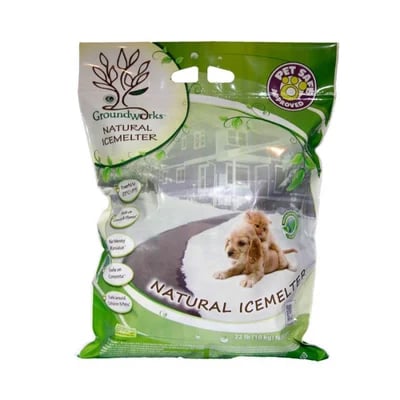
10. Lobby for Change
Does your municipality have a bylaw against using toxic ice-melting products? Or against traditional antifreeze (ethylene glycol) that can be deadly for pets who ingest it?
Icy sidewalks are dangerous for both you and your pet. But for your own safety and that of other dogs, there are sidewalk salt alternatives that are non-toxic to dogs and humans. Many cities have already made the switch to safer solutions.
The best way to initiate change is to raise awareness and provide helpful tips on safer options for your dog as opposed to toxic chemicals.
11. Get Your Pooch a Coat or Sweater
Jackets and sweaters may look silly on dogs, but they can be very useful, too and can cut down the impactive of wind chill.
While some dogs have a fur coat that can withstand cold temperatures and wick away moisture, many dogs do not. Protective gear, like the Hurtta Extreme Warmer, can be a windbreaker, protecting your dog from windchill.
Small dogs or those with short hair can definitely benefit from a layer of clothing in colder temperatures. Walk your dog with a parka or sweater to provide a layer of protection from the cold and wind. If it's raining, you might want to invest in a raincoat.
12. Have A Few Sweaters On Hand
A wet dog coat or sweater can actually make your dog colder outside than his dry, bare fur. Have multiple coats on hand so that you can alternate them on walks throughout the day or dry your pet's coat in the dryer or over a heat vent after each use.
Layering is super easy with the Hurtta Body Warmer. This thermal layer easily fits under any dog coat or sweater to keep your dog warm even in rapidly changing weather.
13. Stick to the Sidewalk
Unless your dog is a cold-loving breed, such as a Siberian Husky or an Alaskan Malamute, you will probably want to keep him out of the deep snowdrifts for longer walks. If cold ice touches your dog's soft and unprotected belly during a dog walking jaunt, he will chill much faster.
Plan your route, avoiding areas that have been salted, if possible. Bus routes, schools, and parking lots are the most likely to be heavily salted.
14. Use Reflectors and Reflective Clothing
In the winter, there's a lot less sunlight in the daytime. Make sure you and your dog wear reflective strips and clothing or use an LED collar or leash for your dog to be more visible in the morning and evening.
Alternatively, there are leash accessories such as dog collar lights, like the Nite Ize SpotLit Collar Light, that you can attach to your dog's leash or collar.
Wearing reflective clothing on dark nights will offer some protection and visibility during winter dog walks.
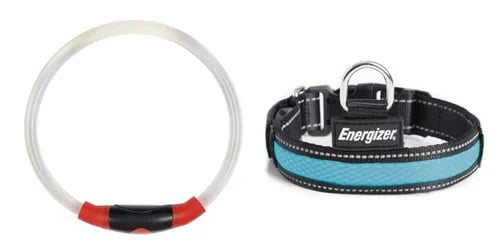
15. Winter Day Walks During the Day
If at all possible, schedule your dog's daily walk in the daylight hours. Not only will it likely be warmer for you and your dog, but you will be more visible to vehicles in the sunlight. Most healthy medium or large dogs enjoy a walk regardless of the weather, but toy or small breeds often balk at the cold conditions.
16. Shovel Snow
While not technically a walking tip, this is a friendly reminder of the golden rule. Be a good neighbour! As a common courtesy, shovel snow on your sidewalks as soon as you can once it falls. This makes your sidewalk much more hospitable for both you and your pets when walking.
17. Limit Snow Intake
It may seem harmless, but even a little snow is not good for your dog to consume, and we aren't just talking about the yellow kind.
A little of the white stuff is unlikely to do any damage, but eating snow does have its risks. It can definitely hinder your pup from staying warm as the animal's core temperature dips.
For one thing, you never know what may be in the snow - antifreeze, chemicals, or some other contaminant. In excessive amounts, snow can cause intestinal upset, including vomiting, in some dogs.
18. Stop Grazing
While it may seem logical, take extra precautions to ensure that your dog is not ingesting anything he finds while on his winter walk. Chemical ice and snow melting products, road salt, and antifreeze are all very common finds on winter sidewalks, and each can be quite damaging to your pet.
19. Watch for Frostbite When Winter Dog Walking
Frostbite can be a real threat to pets, who, like kids, might be having too much fun in the snow to notice frostbite while it is happening. Watch ears, nose, footpads, and tail, as these are the most common places for frostbite in dogs during snow and freezing temperatures.
If you suspect your dog's extremities are showing signs of being too cold during outdoor time, then try physical stimulation to warm up the paws, tail or ears.
20. Alleviate Arthritis
Cold winter conditions can aggravate conditions such as arthritis in your dog. If your pet suffers from arthritis, you may want to keep winter walks shorter and avoid slippery or rugged terrains.
Natural dog health supplements, such as glucosamine and chondroitin, are helpful for lubricating joints and soothing pain associated with arthritis.
21. Keep a Tight Leash on a Winter Walk
When walking around ice-covered areas, such as frozen lakes or ponds, keep your dog on a tight leash and don't allow him to roam on the ice. There's no way to easily tell how solid the ice is, and your dog could fall in, pulling you along with him.
22. Have Up to Date ID
Does your dog have proper identification on his collar or a microchip? Make sure that you keep your information current in case your pet gets out.
Up-to-date information on an engraved dog ID tag, microchip, or city license may be the difference in your pet getting home safely or not.
23. Adjust Dog Food If You Need To
Pets who are spending more time outside in the winter will require more energy, so you should adjust their food accordingly. However, if your dog is mostly spending his time indoors, you may actually need to cut down his portions slightly.

24. Avoid Metal
Everyone knows not to lick metal objects in freezing conditions. While this can pose the same threat to your dog's tongue as yours, it's not the only metal you should be concerned about.
If you are walking your pet in winter, steer clear of metal lampposts, metal plates, manhole covers, electrical boxes, and other metal objects, as these carry with them the risk of electric shock.
25. Try Alternative Exercise
If it's really cold outside and you're struggling with how to exercise your dog in the winter, don't panic!
In the coldest months, pet parents should sign up for an indoor class with their pup or use an indoor walking area to boost wintertime activity levels.
Dog Walking in Winter FAQs
Can I walk my dog in the snow?
Yes, you can walk your dog in the snow, but you might want to outfit your dog in boots and a jacket for extra warmth.
How long can dogs walk in the snow?
Walking your dog should only take 15 to 20 minutes in freezing conditions. Also, watch for signs that your dog might be uncomfortable, such as shivering or whining or if the dog's paws look sore.
Do your dog's paws get cold walking a dog in winter?
When walking your dog in winter, your furry friend's paws can get cold in the snow, with small ice balls developing in the fur between the paw pads, which bring down the dog's body temperature.
Can I adjust the timing of walks for winter weather?
Yes, choose warmer parts of the day when walking dogs and be mindful of low light conditions. Additionally, shorter but more frequent walks might be better in very cold weather to avoid overexposure.
What clothing should I consider for my dog during winter walks?
Depending on your dog's breed and tolerance to cold, you might want to dress your pup in a well-fitting dog coat or sweater to help keep them warm during winter walks.
Can dogs get frostbite?
Yes, dogs can easily suffer frostbite. Any part of a dog's body that is exposed to the cold or excess moisture can easily start to show frostbite signs, so keep your dog warm and limit outdoor time.
.png?width=200&height=66&name=logo%20(1).png)






.jpg)
